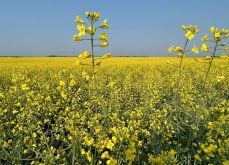WINNIPEG — Like most farmers, David Altrogge likes to talk about yield.
Altrogge has spoken to multiple growers this fall in northeastern Saskatchewan and he’s learned that most producers were disappointed by their canola yields.
In a good year, farmers in the region around Melfort and Humboldt would post yields higher than 50 bushels per acre.
Read Also

Farm writers descend on Winnipeg for eye-opening conference
Digital editor Greg Berg reports on the Canadian Farm Writers Federation conference held in Winnipeg in September 2025.
That didn’t happen this fall.
“Nobody got over 50 on canola,” said Altrogge, who farms near St. Benedict, Sask., southwest of Melfort.
“We’re all in the mid-30s or low 40s (bushels per acre). That’s where we’re all at.”
Below average yields in one of the best regions in Saskatchewan for growing the oilseed partially explains why Canada’s canola crop could be much smaller than anticipated.
It’s possible that 2024 production could be in the range of 17 to 18 million tonnes, significantly lower than Statistics Canada estimates of 19 million.
In late October, the provincial agriculture departments in Saskatchewan and Alberta released their estimates for average canola yields.
In Saskatchewan, the final crop report for the year was published Oct. 30. It pegs the average canola yield at 32.7 bu. per acre.
The figure is almost the same in Alberta — 33 bu.
StatCan says Alberta and Saskatchewan farmers seeded about 18.7 million acres of canola.
Using the provincial estimates for yield, canola production in Alberta and Saskatchewan could be around 14 million tonnes.
Add three million tonnes from Manitoba and the total is 17 million from the Prairies.
In September, Statistics Canada projected a canola crop of 18.98 million tonnes and average yield close to 38 bu. per acre.
Bruce Burnett, director of weather and crops information for Glacier FarmMedia MarketsFarm, said the provincial yield estimates are not as statistically valid as other sources of information.
Regardless, the numbers are the “best data we have that is boots on the ground data.”
“Directionally, they (the provincial estimates) are certainly accurate,” Burnett said.
“Whether we come in with those (final) numbers or not (for yield), that’s another thing…. I think, directionally, this is right. We’re going to see a smaller crop than currently is being forecast.”
Glacier FarmMedia MarketsFarm recently reported that few traders have confidence in the 18.98 million tonne estimate.
Many think the canola crop could be around 18 million tonnes, or maybe lower.
“I think the big question now is whether it’s going to be 17 (million tonnes) and change, or is it still going to be the low 18s,” Burnett said.
A provincial crop production adviser who works in the northeast believes the Saskatchewan yield estimate is accurate. The province has a team of crop reporters — mostly producers — who cover the range of soil types of Saskatchewan’s geographic regions. The provincial numbers are based on those reports.
The Saskatchewan average could be slightly higher than 33 bu., but it’s become obvious that canola yields are well below average.
A wet spring followed by oppressive heat in mid-July hammered canola fields across much of Western Canada.
The crop didn’t develop sufficient roots in June because the soil was saturated. When the heat arrived in July, canola plants didn’t have the necessary root structure to cope with the adverse weather.
In southern Saskatchewan, the 30 C heat and lack of rain in July and August was very stressful for canola.
“South of Highway 13, there was lots of canola that was under 20 bu., which is even worse than last year,” said Travis Wiens, an agronomist with MNP in Milestone.
In recent years, farmers in Saskatchewan’s northern grain belt have posted some of the highest canola yields on the Prairies. Those normally pull the provincial average upward.
In 2023, the average yield in northeastern Saskatchewan was 46 bu. That’s nearly 10 bu. higher than the 2024 provincial estimate of 37 bu. per acre.
On Altrogge’s farm, the main yield robber in 2024 was sclerotinia, a fungus also known as white mould.
He applied fungicide to about 30 per cent of his canola acres to control sclerotinia this summer. It clearly made a difference because those acres produced eight bu. more per acre.
“Eight bu. per acre, that’s phenomenal…. I wished I would’ve sprayed the whole damn farm, not just a third of my (canola) acres,” Altrogge said.
On other farms, a different fungal disease — verticillium stripe — may have dragged down yields on the Prairies, Altrogge added.
“Everybody has a different story, (but) for our farm, sclerotinia was a huge impediment to reaching our yield targets.”
Statistics Canada will release its official production estimates for canola and other crops in December. It’s a safe bet canola will be lower than 18.98 million tonnes.
“The provincial governments have a pretty good handle on which direction this yield is going to be going, for the final report,” Burnett said.
“Some other data is starting to show that the canola yields are lower than those original StatsCan numbers.”
















